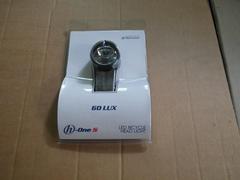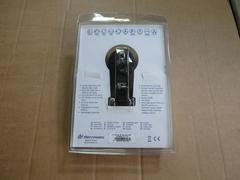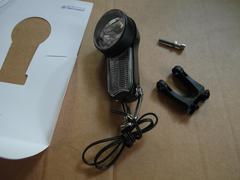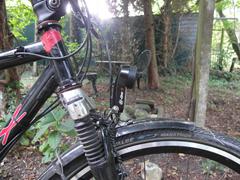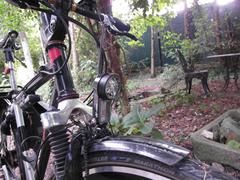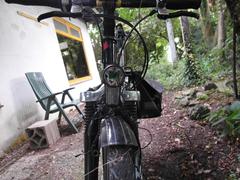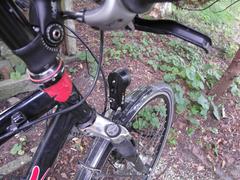Herrmans H-one S
Update 2022-3-14: Last year I used the H-one S again on a relative's bike. It was outside a lot and suddenly it became very dim. I drilled out the rivet, then stuck in a knife to pry the pastic part away from the aluminium housing. The legs of the 5mm DRL LEDs were completely corroded. I removed them, desoldered what was left of the feet, cleaned up everything, and it worked again. The corroded metal formed a bridge with the power transistors, which obviously would only be able to supply a small current but it was enough to made it not work properly. I will upload some pictures of the corrosion.
Tested: 60/75 lux version, from 23 Aug. 2012, 75/95 lux version: from 2 Jan. 2013.
Experiences, 60/75 lux version:
Introduced at Eurobike 2011 but long delayed, I could only buy one in summer 2012.
The H-one S is similar in shape to the Edelux when you use its clip-on reflector. It's pretty heavy at 120g.
Before my test I wrote this in the section of headlamps that could be of interest:
"Herrmans H-One S, 60 lux, integrated reflector. It's fairly cheap but it's also fugly like the IQ Fly".
After testing and mounting it on my bike the ugliness is far less bad than I thought ;-)
The housing is pretty sturdy, it weighs quite a bit at 120g but with a short mounting bracket it should not vibrate. And indeed, it didn't vibrate in my tests.
Mounting hardware is all stainless steel, good. There's a separate plastic mount for Suntour forks. The stainless steel mounting bracket: Not great because you can't keep the bolt on the fork crown easily at the end, it tends to go up (or rather the bracket tends to slide down) while tightening.
This lamp has daylight running lights, and thankfully Herrmans made the light of those LEDs diffuse with the front glass (plastic) of the lamp that's matte before those LEDs. They are quite well visible and at least when running from the standlight power, they are not that annoying. They are not as good as a taillamp type running light would be (see my suggestion about the best daylight running light which would be similar to the light that a good taillamp produces).
I don't like the beam shape. Some artefacts near the front wheel, which are not that bad, but it could be better. Worse is the big hotspot at ca. 10-20 m or better said it's more a 'hot cone', so the area that's overexposed compared to the rest of the beam is expanding like a cone. This gives a similar feeling of distraction as with the Cyo R/Cyo RT. I also don't like the large dark gap from the front wheel to where the beam starts, the poor illumination of the road surface at 30-40 m which you get when aiming it such that opposing traffic doesn't get the full beam in their eyes. The best illumination is obtained by aiming the lamp high, such that the lamp blinds opposing traffic. This means the high lux rating is not maintained over a large distance, and the section of road close to the cyclist is too bright. This means people will tend to aim this lamp too high which means the beam shape for this reason alone is already poor.
Someone from Taiwan mentioned that the squarish section of the beam is actually good for safety in cities. This section, because it's got such strict edges and because it's pretty bright, gets noticed by motorists even if they can't see the bike yet (blind corner).
Auto on/off: To be tested for flickering on/off at dusk. The light sensor is at the rear, so shouldn't be affected by cars' headlamps.
Standlight strength: experiences to follow.
Comparison with the Saferide 60: The Saferide 60 is much more pleasant to use, has similar throw, and not the strong hotspot, or rather 'hot cone'. The beam shape has a lot of the same features, such as a block of light before the main beam, then a sort of cone and a wider illumination that's noticeably less bright. With the Herrmans H-one S the block of light before the main beam has very strict edges and corners, this gives the same problem as with the Cyo RT (it attracts your attention). Also the cone is much brighter than the wider part of the beam which means your attention also goes to the hotspot/hotcone, instead of what is on the road. The Saferide 60, because it also has a bit of a cone shape within the total beam, also has a little bit of the problem that people will tend to aim it too high when trying to get maximum range (thus blinding opposing traffic), but it's not so bad as with the H one S nor the Trelock LS885 in which this is also a bad point. For aiming a lamp correctly it seems essential that a cutoff is strict and remains horizontal and that the beam does not have a hot-cone such as the LS885, H-one S and to a lesser extent the Philips Saferide 60 have.
Experiences, 75/95 lux version:
I wrote on the main lighting page:
Apparently it's been significantly improved, with a different LED and new reflector.
The original lamp, from cursory examination looks to have a Cree XP-E. The LED in this new version of the H-One S looks bigger, and more yellow... I was told the light colour is warmer in this version, well, I will soon see.
First ride: Light colour is indeed better than cool white, looks neutral white or almost so. I will compare with a neutral white (modified) flashlight soon. The beam shape is better for me in that it doesn't have the hard edged block of light before the rest of the beam. The reflector looks the same as in the original H-one S, perhaps it wasn't changed contrary to what I've been told, but they just made use of the blurring that will take place by virtue of a bigger LED die? Anyway, it still has a fairly large gap from the front wheel to the beam, and the start of the beam (the section that was a hard edged rectangle in the original version) is too bright compared to the rest of the beam. It's getting closer to good, but there are still a lot of issues with the beam. Comparing to the Luxos B: I can see farther with it than with the Luxos B, whose beam has a lot more artefacts too. The lamp is sufficiently different from the old version that Herrmans should have renamed this lamp. I certainly can't see as far with this as with the Philips LBL, despite the supposed 95 lux (I didn't use a taillamp). I mentioned the issue of lux rating long ago already on my website, that it doesn't just needs to be high, it also needs to stay high for a certain range on the wallshot to give long distance visibility.
4-1-2013: Ride in the rain, comparing it to the Luxos B and a torch that I modified with a neutral white XP-G LED (colour 5B1, not yet optimal, something like 4C is better):
The first section of the beam, that I think is too high intensity compared to the rest, stands out very well in the rain, it does not disappear. If only the rest of the beam could be made this bright the lamp would be fantastic. I then switched to the Luxos B and there was a big problem with it: The near field in case of rain is very much overexposed because you see almost nothing from the rest of the beam and thus you only see the light close which will remain better to see because of the angles, which makes the problem worse. [ Btw., in my own reflector design in December I chose light to start at 3 m from the lamp, and at reduced intensity there compared to ca. 15m and further... ] So in the rain the neutral white colour of the H-one S kicked ass, and the artefacts and overexposure of the Luxos-B close to the bike are very annoying such that you see very little with it. Especially problematic with glasses and raindrops on it, I felt I was almost blinded by the Luxos B. Comparing the H-one S with the torch: The torch is clearly better in the garden at close range, at larger distance the difference becomes smaller, but there is some difference such as that the grass with water on it looks whiter with the H-one S than with the torch.
I need to do a comparison with the Saferide 60 to finalise my conclusion...
Mounting bracket
I had a report from a user whose mounting bracket broke, and 2 replacements as well. As the bracket is fairly short I didn't expect this and it hasn't happened to me, but checking the bracket the problem is clear: It has been stamped, flattened quite a bit where you mount it on the fork crown. Apparantly too much... (picture to follow)
Beamshots:
For background information on making beamshots see: Camera settings, lamp settings and roads used to make the beamshots.
I made the beamshots without taillamp, giving the maximum brightness of the lamps.
Road 2, camera height 1.65m, camera distance: -0.40m, camera aim: 50m on the road.
Herrmans H-One S version 1 |
Herrmans H-One S version 2 |
Lamp height 0.75m

|
Lamp height 0.75m

|
Conclusion:
60/75 lux version: I don't like the squarish blob part of the beam... A friend of mine really liked that though as it made motorists note him... But it's not available any more so it barely matters now :)
75/95 lux version: The higher lux rating doesn't show at all in use, but the light colour is a lot better than any other lamp that I had tested up to that moment which was clear especially during rain. For the price this is a nice lamp, but I would like to see more light at longer distances (40-50m). The Philips Saferide 60 since around the same time (week 46 of 2012 or earlier) also uses neutral white LEDs, which I only found out about in December 2013, so I will compare these soon.
2022-4-24: Long overdue update: I did this comparison and my preference is the Saferide 60 for a better beam and also a fairly good light colour. As Philips quit, Spanninga took over and released a redesigned Saferide 60 as the Axendo 60 which is in some ways a little better but uses cool white LEDs which are worse. Choosing between the neutral white H-one S and the cool white Axendo 60 is difficult...
Another comment: The H-one S has an aluminium back which is likely cast which means anodising would give issues, and which is then painted black. The paint was peeling off from the corroding aluminium... This also happens with aluminium kick stands. It's quite ugly so I removed all paint.
Last modified: 2022-4-24
